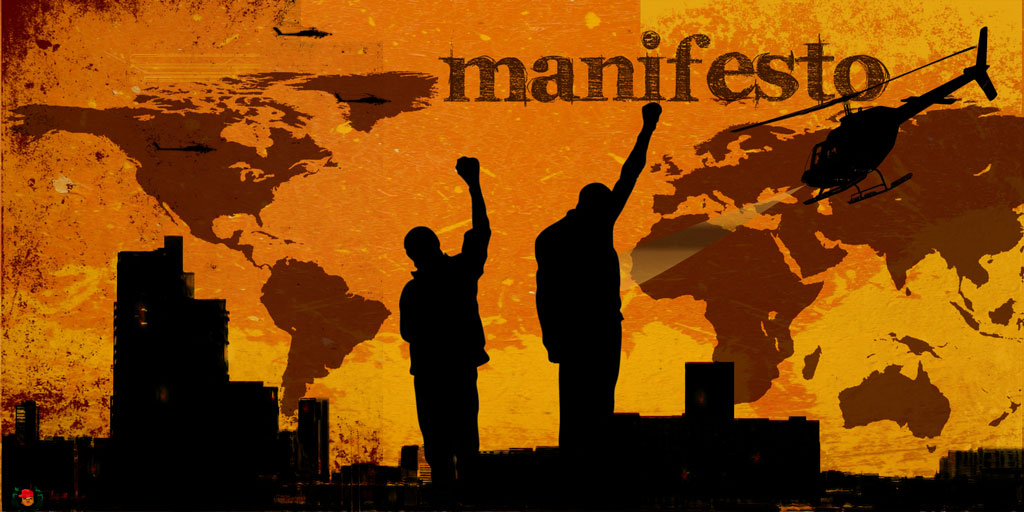103 Days and Marching - Chris "Preach" Smith
 Monday, November 24, 2014 at 10:29AM
Monday, November 24, 2014 at 10:29AM  Photo Credit: Reuters/Lucas Jackson
Photo Credit: Reuters/Lucas Jackson
It has been 100-plus days since the death of young
Michael Brown at the hands of Ferguson, Missouri
police officer Darren Wilson. 100-plus days that have
seen the army of those who are insistent for justice
out in the streets, protesting. Not rioting. Protesting.
100-plus days of stalling, bureaucratic and judicial bait &
switch that is the literal embodiment of a phrase
often invoked by those who don’t want to seriously
confront this pandemic of Black lives being taken
by police: ‘get over it’. Let’s also note that in these
100-plus days and counting, we’ve seen a Black man killed
for holding a toy gun in a Wal-Mart, a mentally ill
Black woman killed by cops in Cleveland, a Black
man in Utah shot and killed while wearing an anime
costume. And in this past weekend alone, a young
father was shot and killed in a dark project building
hallway in Brooklyn and a 12 year old boy was shot
in a Cleveland playground while holding a BB gun. He
later died. This is in addition to the senseless deaths
that include Eric Garner on Staten Island earlier this
summer. The people of Ferguson and their insistence
for justice in alignment with many other people in
New York City, Chicago, Florida and all points in between
are determined to NOT ‘get over it’.
And that’s what scares the privileged powers that be.
So much so that the grand jury in Ferguson, already
compromised in terms of integrity by leaks, is still
deliberating on a verdict everyone expects will be in
favor of Officer Darren Wilson NOT being indicted. The
fear is apparent in Governor Jay Nixon’s calling for a
‘state of emergency’ BEFORE any verdict is announced.
A state of emergency that will call in National Guard
troops. Not for those Ferguson and greater St.Louis
residents buying guns and ammunition to ‘combat’
non-violent protesters. Not as a deterrent against the
Ku Klux Klan who have openly supported violence
against protesters and Anonymous to the point of
threatening to shoot anyone wearing a Guy Fawkes
mask. There’s a real fear apparent. A fear that belies
the fact that you cannot continue to ask a populace
to be calm in the face of such state-sanctioned violence.
Not when they are being slain just for breathing while
Black.
You cannot ask for calm while protecting an officer
who has a history or bigotry and aggression, further
shown by a recent tape of Wilson haranguing someone
prior to an arrest. You cannot ask protesters for calm
as this same Officer Wilson is given the freedom to
prune and further manicure a press-ready image to
appease those bigots who see ‘thug’ whenever they
see a person of color. His meeting with reporters in
secret is appalling, but not unprecedented if you can
recall the Trayvon Martin case and the treatment that
George Zimmerman received. The Wilson defenders
have even taken to the desperate tactics of crowdfunding
efforts that suggest Black teens ‘pull their pants up’
or like the former mayor of New York City, Rudy Giuliani
saying ‘Black on Black crime’ is why white cops act
how they act. Such racist tropes and actions are the
crude tools used to protect privilege and profit. It’s
when ‘get over it’ becomes stripped of fake niceties
and is revealed to be these three words: ‘you don’t
matter’. And you’re seeing more of that pop up in
the media out of the mouths of many who either
directly depend on that to pay their bills or indirectly
will support it to cover their happy hour tabs.
Make no mistake, there are many other things going
on that are tied to the movement for justice for Mike
Brown. There’s reasons why you will see some reactions
from people you may work with, have known infrequently
via social media or other means be so quick to either
paint Brown and all the others as superhuman bogeyman
figures or to tell you to get over it. It’s about their
fear. An infantile, embedded fear that they have been
the monster they’ve talked about others aiding. And
it will only grow. Given what we’ve seen these past
100 plus days, it’s a certainty. But the longer people
agitate, the longer that THIS stays on the table rather
than other stories they’d like you to focus on, the more
that there will be change enacted on a wide scale in some
fashion. As Deray Mckesson, one of the organizers of the
protests in Ferguson illustrated on his Twitter feed recently,
the Montgomery Bus Boycott lasted over a year. It’s about
endurance, it’s about insistence, about determination. It’s
what comes about when fear gets transformed into the
chrysalis of steely courage before the protest.  Photo Credit: Inscripto
Photo Credit: Inscripto
When you give thanks this Thursday, give thanks to those
out there on the streets in Ferguson. Give thanks to the
folks marching, organizing. Give thanks and support to
those parents who lost their children, to the families who
stood up despite their tears. Support them if you can, how
you can. And most of all, pay attention.













